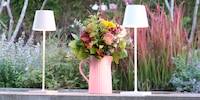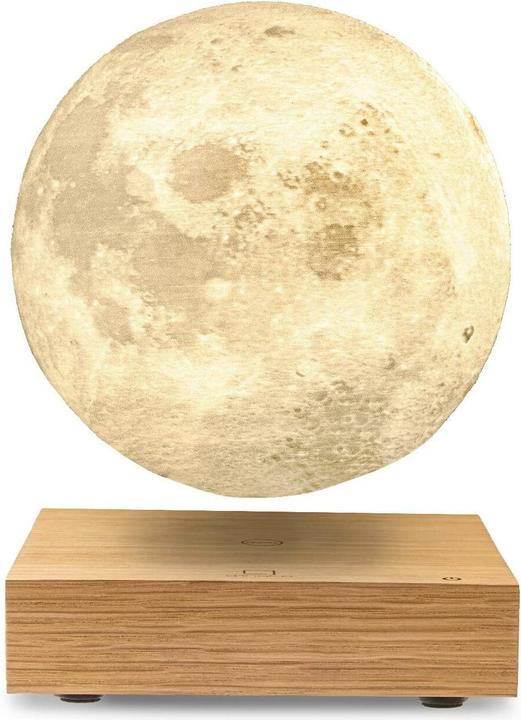
Physical enlightenment: Gingko’s Smart Moon Lamp review
The glowing sphere of this Gingko table lamp looks like the moon. Magnets allow it to float above the base, and it even rotates. This is more fascinating than my physics lessons ever used to be.
Everything today either has to be «smart» or uses some kind of AI, otherwise marketers must fear it won’t sell. Even table lamps are sold as «smart». In this review, I find out whether the Gingko’s Smart Moon Lamp is deserving of this adjective. As you can see in the video, I sometimes even have to resort to brutal means to get answers.
First impressions
After unboxing the lamp, I was initially disappointed as it’s much smaller than expected. And the white plastic globe looks cheap. Made from PLA using the 3D printing process, it has a diameter of 14 cm.
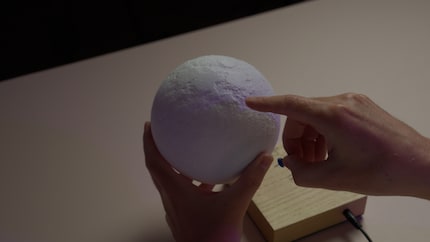
Source: Ambra Antonelli
The surface has a moon-like appearance. This arouses my curiosity, and I try to pinpoint some of the striking lunar landscapes. There are grooves, craters, high plateaus, peaks and lunar mare. When I compare it with a map of the lunar surface, I actually recognise Mare Tranquillitatis, where Apollo 11 landed in 1969. I find the moon crater Copernicus. But I decided to pause my geological walk for now since there’s still more to put to the test.
Does the Smart Moon Lamp also light up? To find out, I first have to place the ball on the base, which needs electricity to generate the magnetic field. The black mains cable is 1.6 m long and has a 12-V adapter plug. It features a compact design that leaves the other two terminals free in a typical Swiss T13 triple socket.
Magnets and sensors to make it float
Once connected to the power supply, the base generates a magnetic field for the moon. There are also magnets at the bottom of the globe that have the same polarity. Repulsion is what allows the moon to float above the base. But according to Earnshaw’s theorem, this repulsion alone isn’t enough. It would be unstable and the sphere would fall down. That’s why there are also sensors in the base that constantly measure the position of the moon and electronically readjust the strength of the magnetic field. In case my physics teacher is now wondering how I know this, even though I was a dud at school, I looked it up.
At least that’s the theory, but in practice, it takes a few attempts before I get the globe to float. The manual reiterates the need for patience. Apparently, some buyers have already complained to the manufacturer when they’ve failed to accomplish this little stunt. They then slammed the globe against the wall in frustration and want their money back.
Patience is key to set up this product and you may need to try a few times before you can successfully levitate the moon.
But I’d assume that everyone can manage it with a bit of effort. If the moon ends up crashing down too many times, you can and should use a small cork pad to cushion the impact on the wooden base.
Now it’s reached magnetic levitation. The moon has found its position at a distance of just under two centimetres. Even a gentle nudge doesn’t make it fall. If you have cats or small children I’d put the lamp somewhere it won’t become a toy.
Three levels of moonlight
Once the moon is floating, you can illuminate it. There are three modes: 2,700 K yellow-warm light, 3,500 K warm-white light and 5,000 K cold-white light. For context, daylight has about 6,500 K.
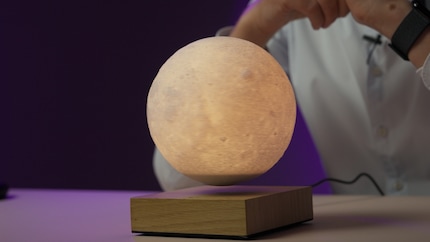
Source: Ambra Antonelli
To change modes, you press the touch switch on the base. The first tap switches the light off, while the second switches it on again in one of the three colours. To change from one light colour to another, you always need at least two taps. While it’s a bit tedious, it’s better than having yet another mini remote control or needing to install an app. The only thing it’s lacking is a dimming function.
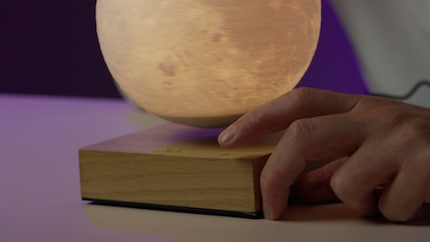
Source: Ambra Antonelli
In case you’re wondering how the LED inside the moon lights up wirelessly, it’s down to induction. Just as you can charge your smartphone without a cable, the electricity here also flows in the form of magnetic waves.
As the moon turns, so does your electricity meter
According to the manufacturer, the floating moon should also rotate. That actually happens when I nudge it. To ensure this doesn’t stop, the electromagnets in the base provide the drive, so to speak, by switching them on and off in a certain pattern. If you look closely, you can see the switching frequency, since it turns in anything but an even way. This means Gingko is breaking a promise, as the lamp doesn’t mimic «the elliptical orbit of the real moon».
Obviously, rotation also costs electricity. I measure a very frugal four watts with my Smartplug from MyStrom when the moon shines cold white at 5,000 K and rotates. The LED itself consumes 1.5 W, but the electromagnets also draw power. There are losses with induction transmission.
If I switch the light off, the rotation also stops. However, the moon is still held in magnetic levitation in standby mode. Current also flows here, where I still measure 0.9 W. If the lamp were on standby 24/7 for a year, that would be eight kilowatt hours, which costs around 2.50 francs.
If you want to avoid paying that, you need to disconnect the socket from the power supply. Then the sphere will stop floating and you’ll have to be patient and set it back up next time.
In a nutshell
Physical enlightenment
Pro
- Stands and floats stably
- Realistic depiction of the lunar surface
- Three pleasant light tones, depending on the mood
- Low power consumption
- Over time, setting up the lamp is easy
Contra
- No dimming function
- Doesn’t constantly rotate

Journalist since 1997. Stopovers in Franconia (or the Franken region), Lake Constance, Obwalden, Nidwalden and Zurich. Father since 2014. Expert in editorial organisation and motivation. Focus on sustainability, home office tools, beautiful things for the home, creative toys and sports equipment.

